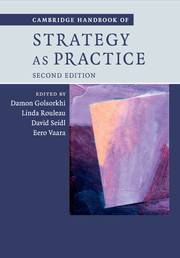Book contents
- Frontmatter
- Contents
- List of figures
- List of tables
- List of boxes
- List of contributors
- Preface to the Second Edition
- Introduction: what is strategy as practice?
- Part I Ontological and Epistemological Questions
- Part II Theoretical Resources: Social Theory
- 8 Giddens, structuration theory and strategy as practice
- 9 An activity theory approach to strategy as practice
- 10 A Bourdieusian perspective on strategizing
- 11 An economies-of-worth perspective on strategy as practice: justification, valuation and critique in the practice of strategy
- 12 A Wittgensteinian perspective on strategizing
- 13 A Foucauldian perspective on strategic practice: strategy as the art of (un)folding
- 14 A narrative approach to strategy as practice: strategy-making from texts and narratives
- 15 Actor–network theory and strategy as practice
- Part III Theoretical Resources: Organization and Management Theories
- Part IV Methodological Resources
- Part V Substantive Topic Areas
- Index
- References
10 - A Bourdieusian perspective on strategizing
from Part II - Theoretical Resources: Social Theory
Published online by Cambridge University Press: 05 October 2015
- Frontmatter
- Contents
- List of figures
- List of tables
- List of boxes
- List of contributors
- Preface to the Second Edition
- Introduction: what is strategy as practice?
- Part I Ontological and Epistemological Questions
- Part II Theoretical Resources: Social Theory
- 8 Giddens, structuration theory and strategy as practice
- 9 An activity theory approach to strategy as practice
- 10 A Bourdieusian perspective on strategizing
- 11 An economies-of-worth perspective on strategy as practice: justification, valuation and critique in the practice of strategy
- 12 A Wittgensteinian perspective on strategizing
- 13 A Foucauldian perspective on strategic practice: strategy as the art of (un)folding
- 14 A narrative approach to strategy as practice: strategy-making from texts and narratives
- 15 Actor–network theory and strategy as practice
- Part III Theoretical Resources: Organization and Management Theories
- Part IV Methodological Resources
- Part V Substantive Topic Areas
- Index
- References
Summary
The firm is not a homogeneous entity that can be treated as a rational subject – the ‘entrepreneur’ or the ‘management’ – oriented towards a single, unified objective. It is determined (or guided) in its ‘choice’ not only by its position in the structure of the field of production, but also by its internal structure, which, as a product of all its earlier history, still orients its present… Its strategies are determined through innumerable decisions, small and large, ordinary and extraordinary, which are, in every case, the product of the relationship between, on the one hand, interests and dispositions associated with positions in relations of force within the firm and, on the other, capacities to make those interests or dispositions count, capacities which also depend on the weight of the different agents concerned in the structure, and hence on the volume and structure of their capital.
Bourdieu (2005: 69)Introduction
With the spread of strategy-as-practice research (see introduction, this volume; Heracleous and Jacobs 2011; Vaara and Whittington 2012), the focus has been on how strategy is actually performed in organizations. Strategy is more than something written in a strategic plan (Whittington and Cailluet 2008) or just relying on top management decision-making. SAP researchers have built upon major social theories (Sandberg and Tsoukas 2011; Seidl and Whittington 2014; Vaara and Whittington 2012) to define practice from different perspectives, but mostly emphasizing that practice is a human activity in relation with a strong social context. It is no surprise that the ideas of the French sociologist Pierre Bourdieu (1930–2002) have been used from the very beginning of strategy-as-practice research in some seminal works, such as those by Jarzabkowski (2005), Whittington (2006) and Chia and Holt (2006). In nearly ten years Bourdieu's work has spread among strategy-as-practice studies. It has mostly been used to study how strategy emerges and becomes established in the actions of individuals and institutions (Chia and Holt 2006; 2009); to explore how strategizing bridges the relationship between the micro levels of human activity and the macro levels of social and institutional context (Gomez and Bouty 2011); to investigate strategists, as legitimate entrepreneurs (De Clercq and Voronov 2009) or corporate elites (MacLean, Harvey and Chia 2010); and how strategic practices and discourses maintain domination from corporate management (Laine and Vaara 2007; Kerr and Robinson 2012).
- Type
- Chapter
- Information
- Cambridge Handbook of Strategy as Practice , pp. 184 - 198Publisher: Cambridge University PressPrint publication year: 2015
References
- 3
- Cited by



